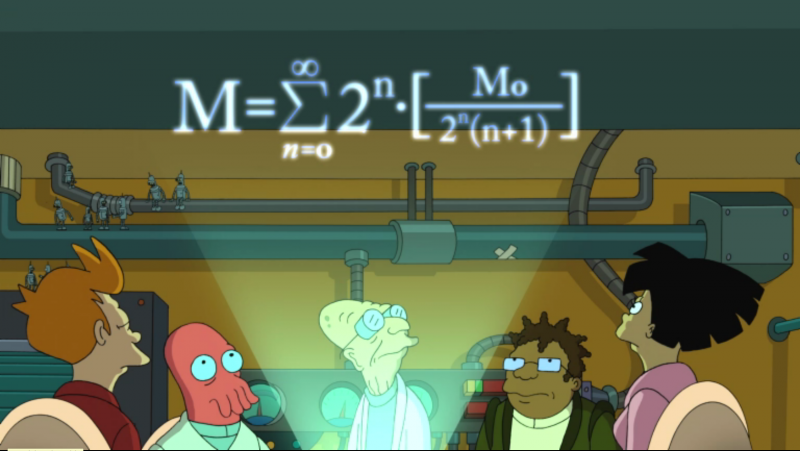
This is a perfect toy for a science geek. The first obvious question it brings: is this formula mathematically correct? As it turns out, it is not. Considering the scale of 60%, the cubic dependency of volume on linear dimension, and the constant density of all copies, the formula should be the following

As you can see the total mass of infinite number of Benders actually converges to approximately 1.76 M0. So from Math perspective there is nothing to worry about. But what if our assumption of constant density is invalid. Would it be a problem from Physics perspective? Let's see.
Knowing that every new copy has a size of 0.6 of the original it was made from, we have the following formula for the size of Bender in the nth generation

This exponential function becomes very small pretty soon. In the 154th generation it already reaches the Planck length, after which the further replication is physically impossible. If we calculate the total mass of 154 Bender's generations using the Professor's formula, we get H(154) × 238 kg ≈ 1,337.56 kg, which is nothing comparing to the Earth mass.
So we have to admit that from both Math and Physics perspective the Professor was wrong, and there was no real threat to the Earth.
Although the Professor's formula doesn't describe the replication process adequately, it's still a beautiful piece of Math because it's a formula of harmonic series. If you want to know why harmonic series is beautiful and which real processes it describes, read this nice article of John H. Webb.
And don't miss the next episode of Futurama this Thursday :-)

2 comments:
Hi there! Just saw Benderama and love it, specialy the math references. Noticed that the professor formula was wrong I looked for some explanation into the web so here i am. I just saw ur serie for the mass and i dont get what u said about the cubic dependency. (i guess that the 3 in the exponent came from that physical fact). Sorry for the bad english :).
I can't remember if there is anything in the episode that specifically decides the answer, but if you take the Professor's statement that each replica is a 60% size version of the last to mean the MASS of each is 60% the mass of the previous the formula becomes SUM [(2^x)*(3/5)^x], which is indeed infinite.
Post a Comment